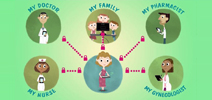Health IT Terms
Important Health IT Terminology
Electronic Health Records (EHRs)
Today, your doctor likely keeps a paper record (sometimes called a "chart") of your information in his or her office. If you're hospitalized, your hospital also keeps a chart. An electronic health record (EHR) is, at its simplest, a digital version of those paper charts.
Digitizing a paper chart has several advantages, including allowing your doctor to easily learn if you are due for preventive screenings or checkups, and keep up to date about your health and health insurance.
Ideally, your doctor's EHR can link to a hospital, lab, pharmacy, or other doctors, so the people who care for you can have a more complete picture of your health.
Today, a small but growing number of doctors and hospitals use EHRs—and more are converting to these systems every day. EHRs are growing in popularity in the health care industry, in part because they can be safer and easier to use than paper, and in part because the Federal government is giving doctors and hospitals incentives to use them to improve care.
Health Information Exchange (HIE)
Health information exchange (HIE) is the movement of health information electronically across multiple organizations. Exchanging health information is important in order to make sure that your health care providers have access to the most up to date information about you so they can make more informed decisions about your care. HIE can improve the coordination of care for a person who is seeing multiple providers by enabling providers to share important health information.
Personal Health Records (PHRs)
A personal health record (PHR) is another health IT term you may have heard already. A PHR is a lot like an EHR, except you set up and control the information yourself. You don't have to wait for your doctor to build an electronic system into his or her practice. One of your health care or health insurance providers may already offer a PHR for you to use. You can also create a PHR through other software and online services.
Much like the EHR, the PHR can be an electronic storage center for your most important health information, such as:
- emergency contacts
- allergies
- illnesses or conditions
- medications
- immunization dates
- lab and test results
Your PHR may also have its own "apps" – programs that are used on smartphones – that can help you, improve your health by linking with other devices such as a web-enabled digital scale or pedometer.
Ideally, you should be able to link your PHR with your doctor's EHR, making it a personal health care "hub," although most doctors may not be technologically ready for this quite yet. PHRs can be maintained in a variety of formats, such as a USB "memory stick" or on a password-protected Internet site.
The advantage of a PHR is that it's all about you. You decide whether to create one in the first place, and what to put in it. Most of what you do for your health occurs outside the doctor's office and you can use your PHR to record that information. You can include:
- Over-the-counter medications
- Exercise habits
- Sleep patterns.
It can even reflect your preferences and values on sensitive issues, such as end-of-life care. It's yourrecord: you know better than anyone else what your record should contain.
For more information about PHRs, check out this video on PHRs and these resources.
Electronic Prescribing
Have you ever seen your doctor or someone at a hospital send an order to the pharmacy by computer? That's electronic prescribing (e-prescribing).
With e-prescribing, your doctor enters your prescription into a computer database. The order for the medication is then sent over a network to your pharmacy, which can fill it immediately.
E-prescribing offers several advantages over today's phone, fax, and paper methods of transmitting prescriptions.
- First, it can save time, because your pharmacist can find out if you need a prescription filled right away, rather than making you wait until after you drop off your prescription slip.
- Second, it can save you money, because a computer system may suggest an alternative or generic drug that is just as good but costs less.
- Third, it should be safer since it may be able to check whether the new drug interferes with any other medications you are on or with any allergies you may have; there is no risk that your pharmacist might misread a hastily scribbled prescription slip and give you the wrong drug. However, e-prescribing, like any other process where people are involved, is not totally foolproof.
Some larger hospitals already have e-prescribing. Many large drug store chains are getting ready to install systems or already have systems in place with this capability. E-prescribing requires that your doctor and pharmacy be linked electronically. Your doctor may not be able to do this today—but it is becoming increasingly common.






